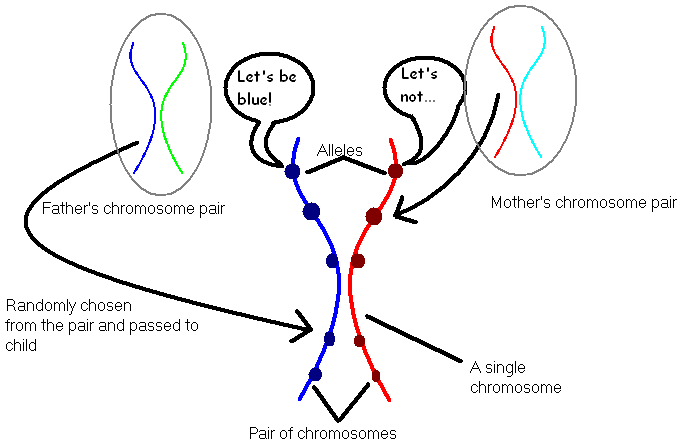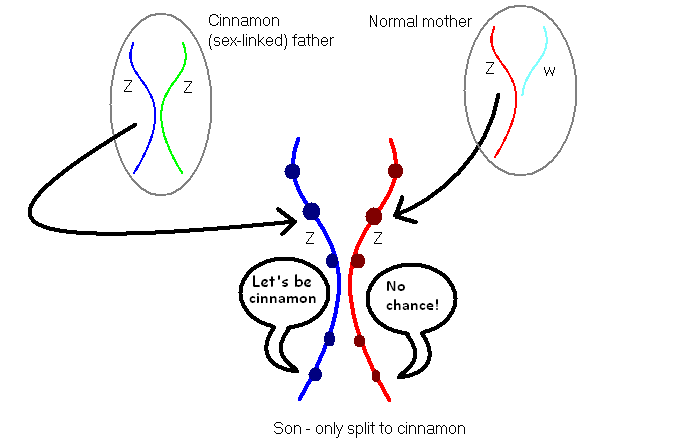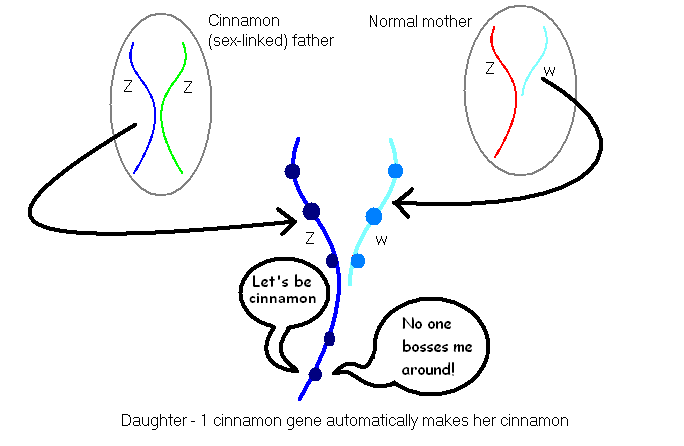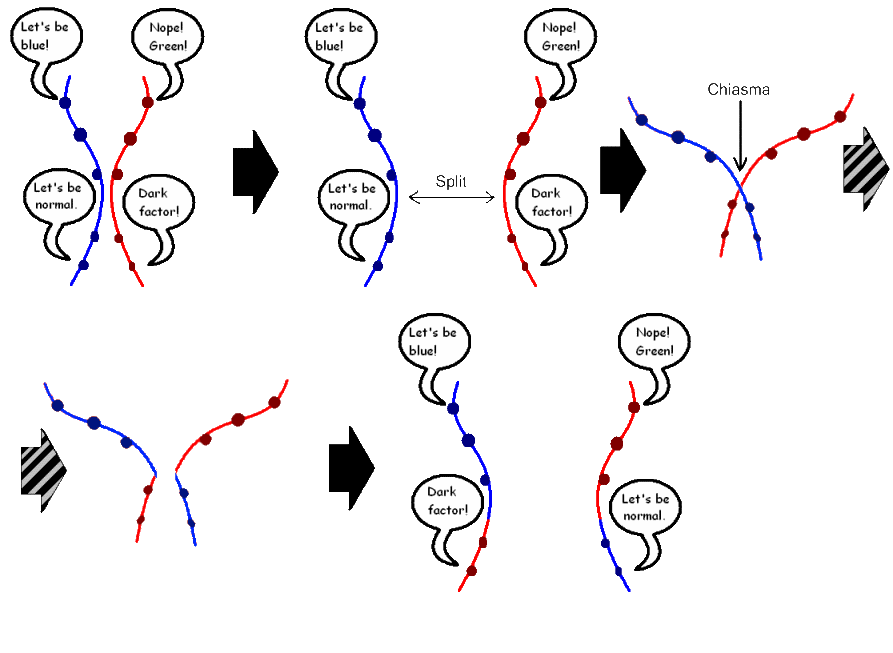 enetics:
enetics:  Quick Introduction
Quick Introduction
|
The genetics of any animal is encoded into structures called chromosomes. Each chromosome is like a list of instructions that tell the creature's cells how to form. The position on a chromosome that contains a single instruction is called an allele. Chromosomes come in pairs - each parent contributing one of the pair by randomly selecting one of their own. This means that for every gene, there are two alleles (instructions) for the same thing. If these instructions are the same, then the out come is straight-forward and you get exactly what you would expect - that instruction is carried out and expressed in the resulting animal. What happens when the two instuction differ depends on the combination of genes. Some (usually the wild-type, ie. the "normal" version) always over-rule a differing instruction; some always lose to a differing instruction; and some come to different arrangements depending on what they are paired with. The different classes of genes (at least those relevant to Parrotlets) are listed below.  Recessive Recessive genes are always supressed when they are paired with a matching gene that has a different instruction, but are expressed when paired with another copy of same instruction. The Blue mutation in Parrotlets is an example of a recessive gene. It carries the instruction not to produce yellow pigment in the contour feathers, which has the effect of turning green plummage blue. Where B represents the wild type instruction on this gene (allowing yellow production and leading to normal green birds) and b is the mutated instruction that leads to blue birds, we have: BB = Visually green bird. Bb = Visually green bird. Known as a "split" these birds carry the mutation, but don't show it. The difference between this and the BB combination is that the Bb bird can still pass the mutation on to it's off-spring, and (partner depending) may have blue chicks. bb = Visually blue bird. This bird not only displays the blue mutation, but it always passes the gene on. All of it's offspring will be at least split to blue, and can be visual blue if the other parent also passes on the b gene. Dominant In contrast to the recessive gene, a dominant gene is always expressed on a bird that carries it, irrespective of it's partner instruction. An example in the Parrotlet world would be one of the Pied mutations Where P is the instruction to be pied, and p is the wild-type gene that produces normal, unpied birds, we have the following possibilities: pp Normal unpied bird. Pp Pied bird. May or may not pass the mutation on to it's off-spring. PP Pied bird. Will always pass the mutation on to it's off-spring. Incomplete Dominant This is similar to the dominant genes above, except that in the event of a mismatch, this gene "compromises" with its partner instruction and only partially expresses. It is believed that the Parrotlet Dark Factor mutation follows this inheritence pattern. Here, D is used to denote Dark, and d normal: dd Normal bird. Dd Darker bird than normal. DD Much darker bird than normal. Autosomal A gene is autosomal if it is not carried on the sex defining chromosomes. If a gene is not autosomal, then it is sex-linked. Sex-Linked Sex-linked genes are simply any gene that has it's alleles on the sex defining chromosomes. In birds, and therefore in the rest of this article, that means the Z and w chromosomes; in humans and many mammals (and also a few types of insect) these would be the X and Y chromosomes respectively. Although this article is written with birds in mind, the ideas here can be extended to humans as long as you remember that in birds males are ZZ and females Zw, but in humans roles are reversed with females being XX and males XY. From here on I will be writing strictly about avian genetics; if you want to convert to humans, swap all references to "male" with "female", "father" to "mother", "daughter" to "son" etc. Sex-linked mutations are very similar to recessive genes, but with the complication that the w chromosome does not have a complete set of alleles. Sex-linked genes are the ones that sit on the portion of the Z chromosome that has no equivalent on the w. When a female bird inherits such a gene - always from her father since she must get a w from her mother in order to be female - she has no second allele to over-write the instruction, and thus always expresses it. A male, on the the hand, inherits these mutations in a fashion almost identical to recessive genes, getting a Z from both parents and thus two copies of the allele. This means that a male can be unaffected, split or visual for a sex-linked mutation; a female can only ever be unaffected or visual. 

A consequence of this set up is that a hen who carries a mutation in this fashion will always pass it to her sons (although if they are to be visuals and not just splits, their father must also pass it). An even more profound consequence is that if a father is a visual all his daughters will be visuals, and if he is split, 50% of his daughters will be visual; the hens genetics will not have any affect on her daughters for this mutation. Punnette Squares Punnette Squares are a handy way of working out on paper the various possible out-comes when you pair two birds, whose genes you already know. You simply make a table, with all the combinations of the male's genes down the side, and the female's across the top. In the squares inside the table you simply write the female's gene for that column and the male's gene for that row. If a genotype appears in one of the boxes in the filled out table, then it is possible that the pair of parents can have such a baby. The number of boxes also tells you how likely it is - for example if there are 4 boxes in the table and the gene combination appears in 2 of them, you have a 2 in 4 chance of getting that baby. Let me give you some examples. Let us assume that we have two visual green split-to-blue birds that are mating. That means both have Bb for the genes we are interested in. That would give:
From this, we can easily see that we have a 1-in-4 chance at a BB baby (green, not split), a 2-in-4 chance at a green split-to blue baby (Bb) and a 1-in-4 shot at a visual blue (bb). Now let's try something more complicated. Suppose we have a visually lutino hen who is also split to blue, and she is paired with a male who is visually green, but split to both lutino and blue. Where the capital letters are the wild-type normal green gene, and the lower-case the mutation; this pair is then ll Bb crossed with Ll Bb. We will put all that in the table, with some colour coding so you can see what's going on:
Looking at the table we can see that we have:
Chiasmas Generally speaking, we assume that each gene is on a different chromosome. This would mean that each mutation is independent, and if a bird has more than one mutation to pass on, it can pass any combination of those genes. This isn't entirely true; for example evidence suggests that the Blue and Dark mutations are on the same chromosome. Naively, this would mean that the genes are not independent, and that a bird that had received one mutation from one parent, and the other mutation from the other parent could only pass one mutation to it's off-spring or the other - never both or neither. In actual fact, as long as two genes are sufficiently far apart on a chromosome, our approximation that they are on different chromosomes is a good one. A bird with Blue and Dark mutations will pass those genes on independently. This is because of something called a chiasma. When a pair of chromosomes split, they can cross over and split apart again, switching part of their structure in the process. Thus a mutation on one chromosome can migrate over to the other, allowing the possibilities of both genes passing on or neither passing on that were previously excluded.  Panels 1 & 2: the chromosome pair divides during sexual reproduction. If the embryo inherits the chromosome pictured in blue, then it will get a Blue gene but not a Dark gene. If it inherits the chromosome pictured in red, it will get a Dark gene but not a Blue. Panel 3: there is a chance of the chromsome pair becoming crossed and attached to each other. Panel 4: if that happens, the chromsomes will seperate again; but not necessarily in the same way they joined. Panel 5: This can lead to the allels swapping sides. If it is one of these chromsomes that will be passed on to an embryo then the baby can inherit both a Blue and a Dark gene together (left), or a normal gene in both positions (right). Between the two chromsomes in Panel 2 and the two in Panel 5, all four possibilities are realised: B+d, b+D, B+D and b+d. | |||||||||||||||||||||||||||||||||||||||||||||||||||||||||||||||||||||||||||||||||||||||||||||||||
|
Page created 28 March 2008 Last modified: 3 April, 2009 Iain D. Kendall | ||||||||||||||||||||||||||||||||||||||||||||||||||||||||||||||||||||||||||||||||||||||||||||||||||






